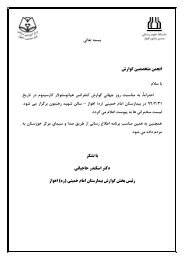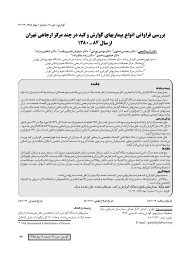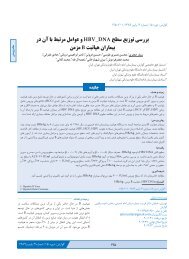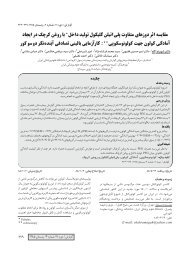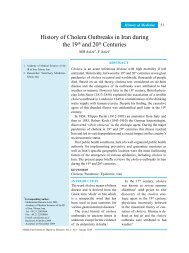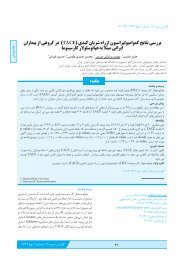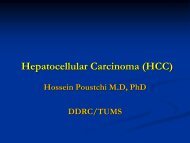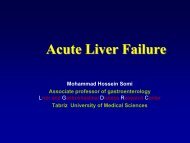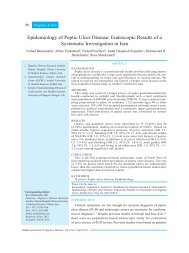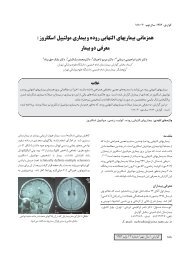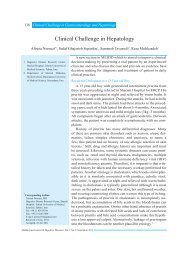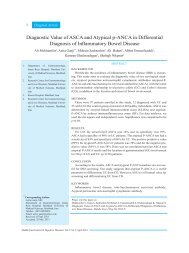A Systematic Review - IAGH
A Systematic Review - IAGH
A Systematic Review - IAGH
You also want an ePaper? Increase the reach of your titles
YUMPU automatically turns print PDFs into web optimized ePapers that Google loves.
Shayesteh et al.<br />
31<br />
Table 1: Assessment for article quality.<br />
<strong>Review</strong>er : 1 □ 2 □<br />
Articles<br />
1st step: Decision after reading the title and abstract. 1 2 3 4 5<br />
Reject □<br />
Accept □<br />
2nd Step: Complete the following when the entire article is read.<br />
Research question<br />
Has the research aim been explained sufficiently and<br />
clearly<br />
Has the population study been clearly defined<br />
Have the outcomes been considered clearly<br />
Are the time and location boundaries explained<br />
Sampling<br />
Has the sample size been appropriately defined<br />
Was random sampling performed<br />
Do selected patient characteristics correspond to the<br />
defined population<br />
Measurements<br />
Were valid and reliable tools used<br />
Were identical tools used<br />
Did a trained interviewer gather data<br />
Analysis<br />
Was subgroup analysis performed<br />
Was there a suitable analysis method<br />
Total score<br />
Final decision<br />
Reject □<br />
Accept □<br />
Reject □<br />
Accept □<br />
Reject □<br />
Accept □<br />
If an article has a considered character, it will be assigned 1 point.<br />
If an article has total score of more than 6, it will be accepted and entered in the next step.<br />
Reject □<br />
Accept □<br />
Reject □<br />
Accept □<br />
Reject □<br />
Accept □<br />
Reject □<br />
Accept □<br />
Reject □<br />
Accept □<br />
Reject □<br />
Accept □<br />
evant scaling, and 4) data analysis. Two reviewers<br />
independently assessed the articles according to<br />
this system. If an article had more than 6 out of 12<br />
points, it was entered into the study and the full text<br />
of the article was evaluated. We chose articles that<br />
evaluated the epidemiology, demographic character,<br />
and risk factors of UC with appropriate methodology.<br />
RESULTS<br />
The search identified 407 potentially relevant<br />
citations (Figure 1, Table 2). From these, we identified<br />
11 case series studies that comprised 1882<br />
individuals diagnosed with UC and 2 case-control<br />
studies. There was 80% agreement between the two<br />
reviewers (A.A.S. and M.S.F.) in assessing study<br />
eligibility. Fani, 11 in a study conducted in Arak,<br />
Iran estimated the incidence of UC to be 3.04 per<br />
10 5 individuals and Masoodi et al. 12 in Hormozgan<br />
Province, Iran estimated the incidence of UC to be<br />
3.25 per 10 5 individuals. The prevalence of UC in<br />
Arak in 2000 was estimated by Fani as 15.5 in 10 5 .<br />
Patients’ demographic characteristics are shown<br />
in Table 3. There were 1039 female patients (F/M:<br />
1.23). Patients’ mean age at the time of diagnosis<br />
was approximately 34 years. In all studies, with the<br />
exception of one study, patients’ mean ages were<br />
in the fourth decade of life One of the studies revealed<br />
a second peak.<br />
Smoking was common in 2.3% to 15.5% of patients<br />
in seven studies. In the case-control studies,<br />
there was an inverse relation between smoking and<br />
the presence of UC (p ≤ 0.002, OR: 0.31921, 13 and<br />
p



